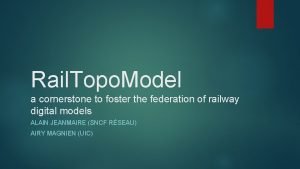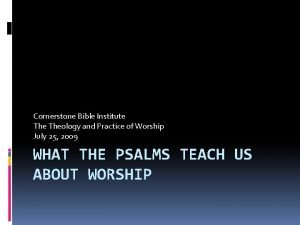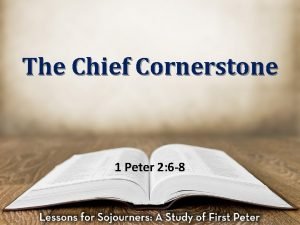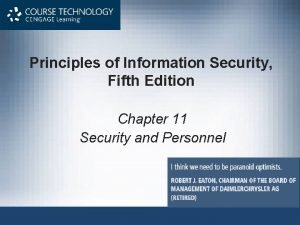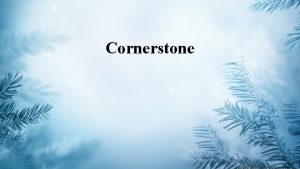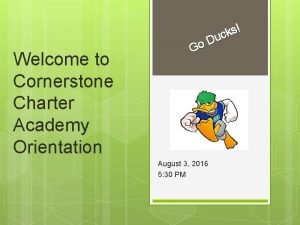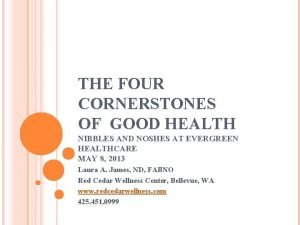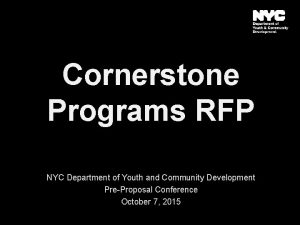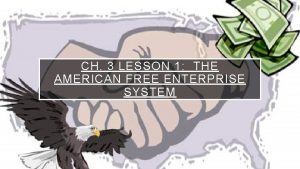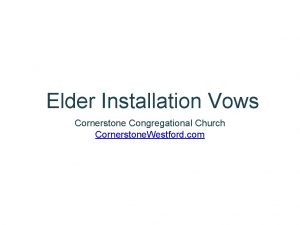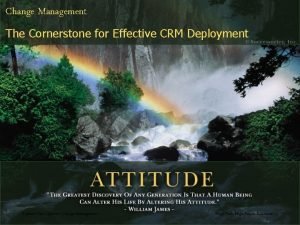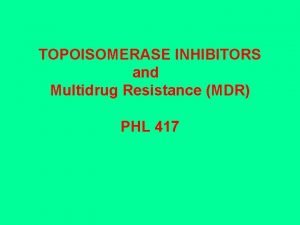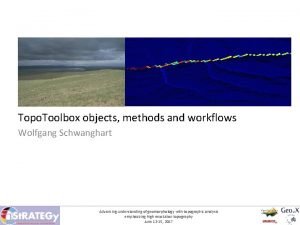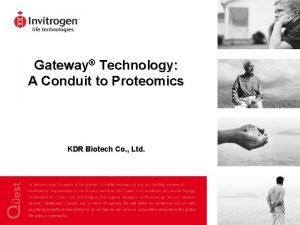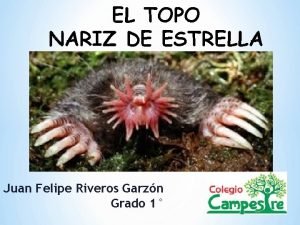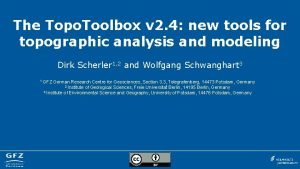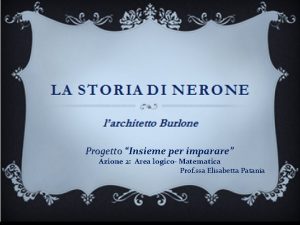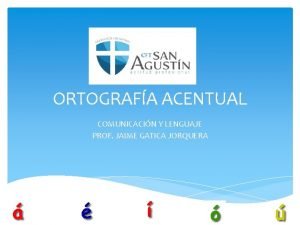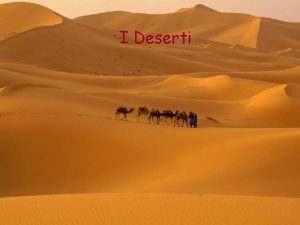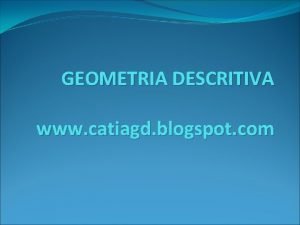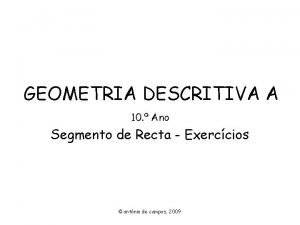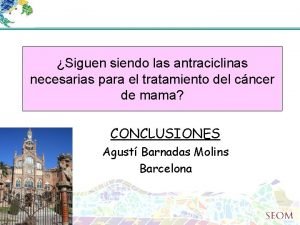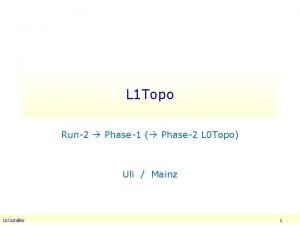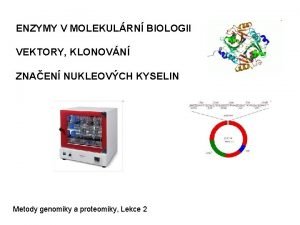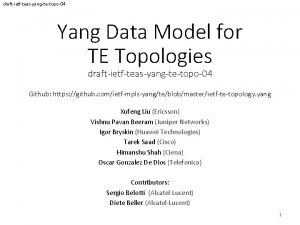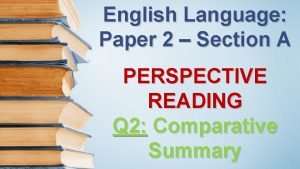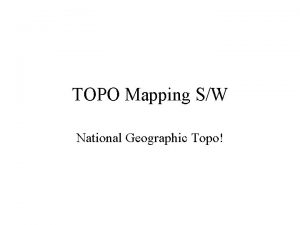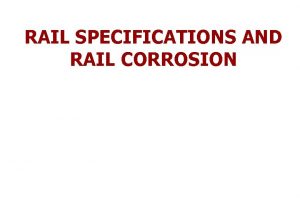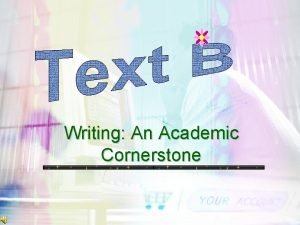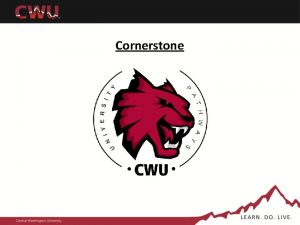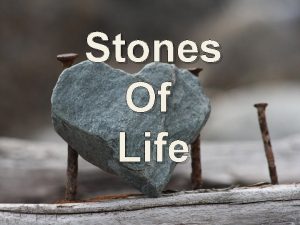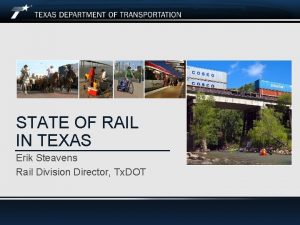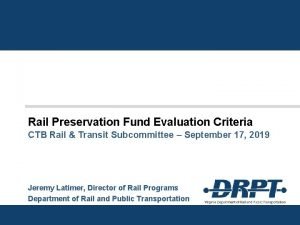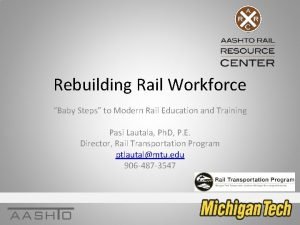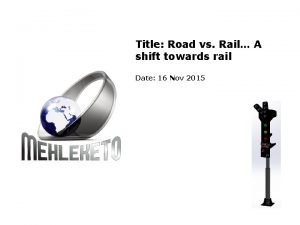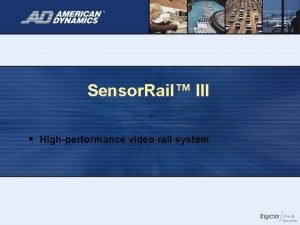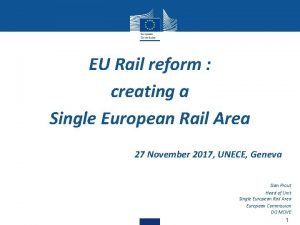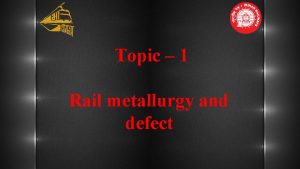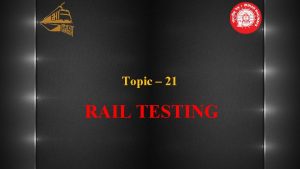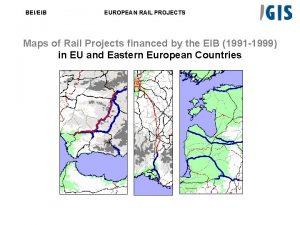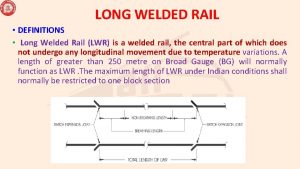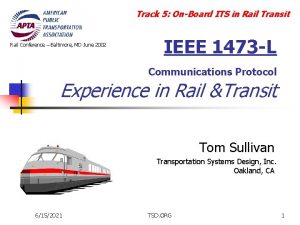Rail Topo Model a cornerstone to foster the































- Slides: 31

Rail. Topo. Model a cornerstone to foster the federation of railway digital models ALAIN JEANMAIRE (SNCF RÉSEAU) AIRY MAGNIEN (UIC)

Contents Rail. Topo. Model (RTM), some insights The importance of being semantic Putting flesh on the bones: comprehensive system representation From model cooperation to model federation: the S²R Common Data Model initiative 2

3 Rail. Topo. Model SOME INSIGHTS

What is Rail. Topo. Model ? RTM = Rail. Topo. Model = Rail Topo Model = Railway topological model An open, free, evolving UIC standard Project Start : 2014 Delivered : IRS 30100 (free download, no licensing fees) Extensions in the works, esp. for BIM and asset management Direct Participants: ADIF, BLS, CFL, CIE, INFRABEL, MAV, ÖBB, PKP, SBB, SNCF, SZDC, ZSR + contributions from Academia and Research (RAILENIUM) 4

What does RTM aim at ? 5 Allow to create, instantiate and maintain the “digital twin” of the railway system … for all business domains “Functional” Description Accurate digital description of the whole Network (including Routes, Track geometry, . . ) At each step of its lifecycle Including multiple levels of referencing (linear, geographic) and detail Asset Management Operational aspect Being able to take over “as built” drawings Support network operation simulation Support asset management, maintenance planning Using one consistent set of permanently updated information Hence, support simulation of power supply and signaling too Of special interest: ETCS, Automatic Train Operation

A glimpse into RTM topology & networks Topology answers the question “what railway network element is connected to what other network element”, regardless of connection type, scale or level of detail. All Network elements (lines, or tracks, or stations…) are graph nodes Elements can be expanded and detailed (macro meso micro) As many topologies as relation types! Navigable = TRUE Navigable = FALSE Macro network level (stations, lines…) Micro network level (tracks) 6

Conceptual clarity ensures extensibility and maintainability 7 Flexible link: object - position Abstract classes for material or immaterial objects Central RTM concept Several scales, but single data repository Data Persistence Time Units Measures Linear or geographic positioning (OGC-compatible) RTM 1. 1 package structure

8 The importance of being semantic MODELS AND ONTOLOGIES

UML Class diagrams: hype, and the deeper relevance Four types of class diagram abuse: 1. Class diagrams as over-sophisticated, under-used object models … • Often w/o methods (platform-specific!) • Often without constraints (OCL is little known!) • Often lacking clear semantics (documentation is costly and boring) • Banning multiple inheritance for good, but also bad, reasons 2. … or as first step in model-driven engineering … 3. … or as an iterative step (conceptual model implementable model) 4. … or rather, an intermediate step? 9

From knowledge to applications Evolutionary path? Offsetting overhead with quality and speed benefits, using model transformation and code generation 10

Ontologies: are they needed? Yes. Example : EULYNX Data Preparation > 430 classes > 4000 properties, of which 1100 are distinct Example : IFC-Rail Bilingual (English, Chinese) from ground up 11

Ontologies: flavors and usages Representational ontology: « dictionary ontology » or or Domain ontology, as formal & explicit business requirements Ontologies as a step in the development Ontologies as a component in architecture 12

Human-manageable, machine-discoverable A slice of LEMON… … and a peek into the draft semantic Wiki … LEMON: multilingual dictionary ontology – W 3 C Media. Wiki + extension: Semantic Mediawiki, RDFIO… 13

14 Comprehensive system representation PUTTING FLESH ON THE BONES

Railway System challenge Information Modeling to ensure Digital Continuity for the whole system, over its whole lifecycle 15

The Railway System is complex … 16 Managing its life cycle and related information is complex ! Rail System behaves as a whole … with its multiple sub-systems and facets, … leading to several Standards … multiple Processes & IT Solutions Design Build Finance Survey ALL processes, actors, solutions contribute to manage the same System … and should act as One : Digital Continuity Maintain Operate

Railway System complexity : sub-systems and facets 17 Railway System is structured in subsystems … each of its concepts has multiple Facets Track System Model should cover all required facets, to be instantiated in IT environments System Facets Concept. ID-D Structural Object Catalogues ID-C Functional Object Design ID-F Field Telecom Object Dictionary Physical Sub Systems Signaling Energy Object Each Facet is represented by a specific Object, with its own UID and related properties. System model and Digital Twin should cover the whole business scope ID-P Each concept, at every level of FBS/PBS/Geospatial Breakdown Structure… is modelled with its multiple relevant facets

System Modelling : Concept life cycle & stages 18 A business infrastructure concept has multiple incarnations during its life and operation Catalogue* Dictionary Business Concepts Referenced Item (Structural) * Enterprise Catalogue with the ‘Internal standard products’ , and Manufacturer Catalogues Digital Twin Maintain + Project Model Requirement (Business) Design Build (Functional) (Physical) State(s) (Physical) Operate + State(s) (Functional)

System Modelling : Concept and related objects 19 At each stage, a concept requires the instantiation of a specific object, with its own Unique IDentifier, and its specific, relevant properties values Catalogue Dictionary Project Model Requirem. Referenced item Objects Properties ID-C X Manufactured Concept Business Design Digital Twin Build Functional Physical Maintain Physical Operate State(s) Functional Func/Phy. Object Object ID-D ID-B ID-F ID-P ID-F ID-XX X X As Built X As Maintained X Identificat. Functional Technical Location Geometry Life cycle Condition Operation Mainten. X As Required X As Designed X X As Designed As Maintained Related to what is traced (survey of infra, simulation of functional, tracking of operation, …)

System Modelling : Object life cycle & Digital continuity (1/2) 20 Each stage / object is precisely related to one/many others all those relations must be modelled 2 Catalogue Dictionary Referenced Item* Business Concept 2 -a 4 3 1 Project Model Requirement Design Business Build Maintain Functional Physical 3 -d 3 -b 3 -a Digital Twin 3 -c Physical 4 -a 4 -b Operate State(s) Functional Func/Phy. 4 -d 4 -c 2 -a A Catalogue is structured on the basis of dictionary objects/properties 4 -a Maintained objects are initialized from built physical objects (handover) 3 -a Requirements are defined on dictionary objects/properties 4 -b Operated objects are initiated from functional objects 3 -b Functional objects (CAD) are designed to fit Requirements 4 -c 3 -c Designed objects are drag/drop from catalogues (when relevant) Infra life cycle requires logging of “photos” (surveys, Io. T & sensors, …) 4 -d Tracking of infra activity (switches, signals, …) requires logging of states 3 -d Infra physical objects are implemented to fit design (when relevant, product from stock with item nbr, …) * Enterprise Catalogue with ‘Internal standard products’ or Manufacturer Catalogues

Some advice for system modelling 21 Ø The main objectives of system modeling is to handle, consistently, all dimensions required to run a system virtually as it lives and operates in real life (“Digital Twin”) Ø One main complexity in modelling a complex system is to initiate it… and enrich it progressively, not knowing what will be the next evolutions (objects, relations, use cases). Ø The major risk being to have to refactor the existing model each time you face unforeseen situation. Refactoring a model is a major cost driver, and a blocker in term of reactivity to business. The answer to this complexity and risk is to design a model “independently of use cases”, Ø Model the functional and physical objects as they are, and not as they are used (at a certain time). Ø Then, in a second step, model “how they are used”. The modeling pattern of choice is the “Mediator pattern”, to handle multiple stages of a concept, in a sustainable and scalable way. Mediator objects = <xx>

Continuity between two related objects is managed via a “linkage object” Asset Manager (IMs, …) 1 ID-F 3 xx 22 Manufacturer ID-C Functional Asset “Functional to Physical” Relation Signal Type AAA Item Ref XYZ From dd-mm-yyyy To dd-mm-yyyy Object Type + Positioning + Relations Object description Properties, 3 D geometry, … Signal Manufacturer Catalogue (Structural) Life Cycle of every Functional & Physical Assets Manufactured products ID-P 2 Physical Asset Item Ref XYZ Field Installation Inventory Management Supply Process 1. Design takes the required functional signal from manufacturer’s catalogue 2. Field get the physical item from the manufacturer / storage, via supply / inventory process 3. History is traced via “functional to physical” linkage object Item Ref XYZ

23 Combining models FROM COOPERATION TO FEDERATION – THE S²R CDM INITIATIVE

Agile, Global System Model ? the challenge 24 • Railway System Model, with its multiple sub-systems and facets, will end to model thousands of objects. • Enterprise performance requires the consistency of the whole, all sub-systems, all facets. • Enterprise efficiency requires agility for each domain; to be refined and adapted to evolution. • A monolithic model is not viable; we require decoupling between domain models, for autonomy but not independency. The challenge is how to let each domain to model its own perimeter (subsystem/facets) with sufficient autonomy for agility, while ensuring further consistency of the whole System model

Agile, Global System Model ? the current situation 25 Functional Each standard handles parts of the system models, both in terms of sub-systems and/or facets Design System Facets Energy Telecom Signaling Track Sub Systems Logical Design-Operate Geometry Design-Build Physical Operate Sys. ML, UML, … Models

Agile, Global System Model ? Means 26 How to preserve autonomy and consistency: Uniquely identify concepts and their relations (properties) across models (UML… or others!) Develop & use domain ontologies The global consistency of multiple ontologies managed by several autonomous teams requires three constraints to be applied by all teams: - A shared dictionary of “functional/physical” objects: Onto. Rail - A shared thesaurus of relations to be initiated, then maintained in Ontorail - An ontology language (OWL) and upper / general ontologies, if useful

Common Data Model project Common Data Model: a vision, and a business project by the Shift²Rail joint undertaking, to benefit from standard models by combining multiple parts of different models for several leading projects. The challenge of CDM project is to make this combination feasible for end users (efficient, and sufficiently convenient, with regards to expected benefits, compared to going for a specific model). 27 Example of a project requiring objects and facets managed by multiple standards Object A Track Object B Signal Object E Environt Object G Traffic Object D Energy Current candidates: RTM, Ontorail, EULYNX, rail. ML, IFC, OGC Object C Rolling Object F Population

Positioning of CDM project: Combining models 28 Once objects, facets and relations required by end users are available in particular models, the challenge is to combine consistently the “parts” yielded by those models: e. g. combine geometry from IFC with functional aspect from RTM and logical aspect from Eulynx ? Conditions for combination of models are - Unambiguous semantics ensure all leading projects use and feed Onto. Rail - Unicity of objects involved in related models - Capability to combine relations from multiple models Considering Classes A and B shared by RTM, Eulynx and IFC models Ø Functional relations between A and B are modeled in RTM Ø Spatial and geometry relations are modeled in IFC Ø Logical relations and behavior are modelled in Eulynx Object A Object B Currently all standardization projects are modelling using UML or Sys. ML, were relations are modeled using a graphical representation. Those graphics can be translated in machine readable language called XMI files (xml), but translation is not standard and XMI files are not always compatible. Moreover the extraction from multiple models, of the only relations required for a usage, will be a fastidious work. A solution for CDM to manage those relations independently from each other, while providing capabilities for extracting, and combining, “what I need for my specific usage” could be to translate all standard models as ontologies in RDF format, handle as a global graph model, and managed in a dedicated repository (triplestore)

Conditions for a successful federation Ø Keep projects aligned on vision (consistency, complementarity) Ø Align the conditions and toolsets used by each project to support the vision (e. g. responsibilities, Ontorail feed/usage, procedures for ontology extraction or model transformation… ) modelling handbook Ø Ensure and control implementation of decisions; organize arbitration when necessary Ø Offer ‘one stop shops’ to developers and other users, including support and means for feedback (model enrichment to follow pace of technology) 29

Conclusion Develop standards, develop on standards, and forget about « the standard that will replace all standards » Open collaboration is the key to success Create an academic network for collaborative railway digitalization: knowledge management, modelling, model transformation, open source software, Usage of the above. 30

Further information Legacy websites : http: //www. railtopomodel. org/en/ http: //wiki. railtopomodel. org/ New website (under construction) : http: //rtm. uic. org/ Download RTM 1. 1 : https: //uic. org/railtopomodel Future : www. Ontorail. org Contact: we recommend the functional mailbox rtm@uic. org 31
 Eulynx
Eulynx Cornerstone bible institute
Cornerstone bible institute The chief cornerstone high school
The chief cornerstone high school The information security function can be placed within the
The information security function can be placed within the My hope is built on nothing less sermon
My hope is built on nothing less sermon Define chief cornerstone
Define chief cornerstone Cornerstone big data
Cornerstone big data Cornerstone employer
Cornerstone employer Cornerstone charter academy bell schedule
Cornerstone charter academy bell schedule Four cornerstones of health
Four cornerstones of health Dycd rfp
Dycd rfp Free enterprise system benefits
Free enterprise system benefits Cornerstone westford
Cornerstone westford Crm change management
Crm change management Bisantrene
Bisantrene Topo oefenen zeeland
Topo oefenen zeeland Topotoolbox
Topotoolbox Gateway technology with clonase ii
Gateway technology with clonase ii Topo nariz de estrella
Topo nariz de estrella Topotoolbox
Topotoolbox Un topo e mezzo in un minuto e mezzo mangiano
Un topo e mezzo in un minuto e mezzo mangiano Apellido jerez lleva tilde
Apellido jerez lleva tilde Topo delle piramidi
Topo delle piramidi Recta de topo
Recta de topo Segmento de recta horizontal
Segmento de recta horizontal Antaciclinas
Antaciclinas Topo
Topo Topo ta cloning
Topo ta cloning Yang data model
Yang data model English language paper 2 rail disasters mark scheme
English language paper 2 rail disasters mark scheme Hình ảnh bộ gõ cơ thể búng tay
Hình ảnh bộ gõ cơ thể búng tay Ng-html
Ng-html
